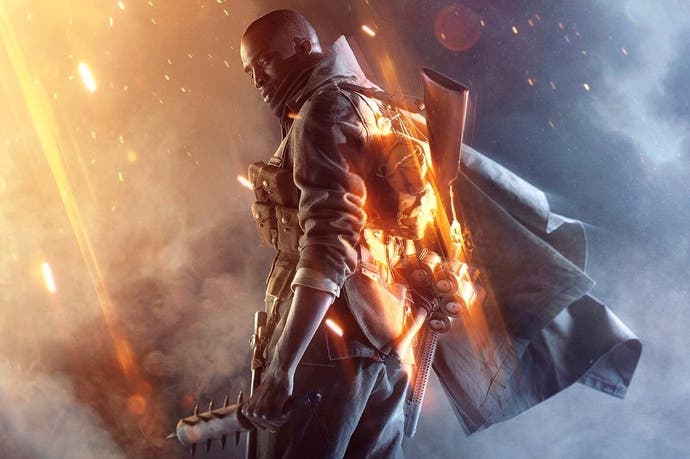Digital Foundry: Hands-on with Battlefield 1
Initial tech analysis, a PC settings comparison preview - plus evidence of DirectX 12 support.
Battlefield is back and with its last update, DICE will have delivered four superb games in three short years - an amazing accomplishment. Battlefield 1 is powered by the latest iteration of its in-house Frostbite engine and this time, the development team is stepping back in time to take on The Great War. The results? Impressive visuals, cutting-edge technology, fast performance and beautiful capes combine to create a beautiful and engaging experience.
With each new release, Frostbite has continued to evolve on both console and PC with enhanced features, improved performance and support for the latest standards. Having spent a solid hour with the game this year at E3, we were impressed with the state of the game so far from release. Even months away from release, Battlefield 1 feels remarkably polished - even in its current state.
In order to best experience the game, EA provided a room full of high-end PCs featuring the latest generation Intel i7 processors paired with brand new Nvidia GTX 1080 graphics cards and G-Sync monitors. And here's an interesting wrinkle - the game's settings UI, which we're told is unfinished, seems to suggest that Battlefield 1 has full DirectX 12 support, unless we've misinterpreted "ID_M_OPTIONS_DX12ENABLED = ON". There's an on/off toggle though, so those still on Windows 7/8 should still be fine. We're still awaiting confirmation of this, but we do know that Star Wars Battlefront on Xbox One used the API, and the developer has confirmed support within the engine.
Surprisingly, each PC at the event we attended defaulted to an automatic mode that opted for medium settings across the board. We quickly made adjustments and pushed everything up to ultra and unsurprisingly, the GTX 1080 chewed right through the game. But the thing is that even at medium settings, Battlefield 1 remains a real looker.
Owing to the unfinished user interface and settings menu, one option that has caused confusion is the resolution scale. While initially confusing, we determined that the slider functions exactly as it does in other Frostbite titles but the labeling is different. In this case, 50 per cent is equivalent to 100 per cent in previous DICE games, with the max setting (confusing labelled 100 per cent) actually corresponding to 200 per cent in older Frostbite titles.
This is something we expect to see fixed in the final game, but as things stand, because we were using 1440p displays, pushing this slider to 100 per cent renders the game at 2880p or 5K resolution. During most of our testing though, we stuck with 75 per cent (4K), which obviously looked very impressive.
Frostbite games tend to scale very nicely and Battlefield 1 is no exception, even in its current alpha state. The difference between low, medium, high and ultra is certainly noticeable but even at the base level settings, the visuals are still impressive. One of the most significant improvements stems from the mesh quality setting. This controls the distance and quality of distant object geometry. Using lower settings, objects disappear from view or appear less detailed at closer distances to the player.
This setting has a significant impact on performance but pushing it up to ultra helps eliminate pop-in while increasing the number of objects players can see at a distance - great for a long range player.
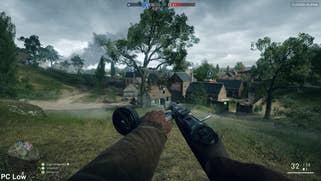
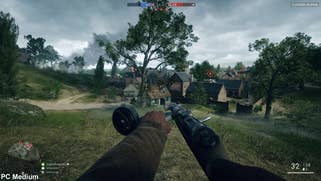
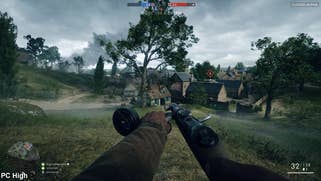
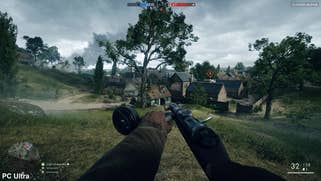
The higher quality settings also enable improved anti-aliasing by default. The alpha UI describes a 4x MSAA option, but we understand this has been removed from the Frostbite engine for some time, replaced in favour of the TAA found in Battlefront and Mirror's Edge. Regardless, Battlefield 1 produces an very crisp and clean image.
Image quality is also boosted significantly by increasing shadow detail and ambient occlusion settings. The higher quality shadows are quite demanding but produce more realistic results with less visible pixilation. As for ambient occlusion, Battlefield 1 offers HBAO as its top setting but we'd love to see other more interesting options in the future. Perhaps Nvidia's VXAO could be interesting?
Using a GTX 1080, we were eager to push settings to the max and were impressed to discover that this card is capable of running Battlefield 1 with all settings pushed to the highest values. We were able to play the game at 5120x2880 (5K) with the ultra preset engaged while still hitting frame-rates just above 30fps. The fact that such aggressive settings could be reached at all demonstrates both the power of the GTX 1080 and the optimised nature of Battlefield 1, even in its current closed alpha state.
Obviously, not everyone playing the game is going to own Nvidia's top tier card and while we weren't able to test other graphics cards, extrapolating downwards, it's clear that the engine is very scalable and should operate well on a variety of systems. Both Battlefront and Mirror's Edge could run at ultra settings at 1080p on GTX 970 and R9 390 with a firm lock on 60fps, and we would hope that Battlefield 1 could follow suit.
Speaking of Battlefront, DICE has made use of one of its key techniques here in Battlefield 1 - photogrammetry. This technique makes use of actual photos for measurements, modelling and texturing in order to produce remarkably realistic results. With Battlefront, many users were familiar with the props and materials created for the Star Wars films but Battlefield 1 focuses more on realism. This means scanning in objects and materials that represent real world objects. Once we have the game in-hand, it should be interesting to examine the level of detail here more closely.
We were also impressed with the ambient weather and lighting. Throughout the match, weather changes dramatically, impacting the atmosphere of any single moment. Watching dark clouds roll in as rain starts to pour over the battlefield is a great moment. It may not have a real impact on gameplay, but it sure does enhance the mood.
After spending an hour with Battlefield 1, we walked away impressed both from a gameplay and graphics perspective. It's still very much a Battlefield game but the change in scenery and the implementation of new weapons results in a more immersive experience overall. The latest iteration of Frostbite also provides some truly remarkable visuals.
Battlefield 1 still has a way to go until release but even in this early state, the game holds a lot of promise, and the level of optimisation here is already highly impressive. While the capture event we attended was focused on the PC version, it should be noted that the Xbox One version of Battlefield 1 was present at Microsoft's booth. From what we could see, this version is still looking good, but it was clearly running at a much lower resolution - and all of DICE's 60fps titles have operated at 720p thus far on Microsoft's hardware. Based on our experience with Star Wars Battlefront on Xbox One and PS4, we have high hopes for the quality of the final title, and hope that the higher player counts in Battlefield's spectacular MP modes don't impact too much on performance.
